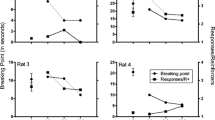Abstract
A multiple fixed-ratio, fixed-interval schedule of food presentation was used to study interactions between naloxone and chlorpromazine in the pigeon. Inactive doses of both drugs could combine to decrease the rate of responding under both schedule components. Inactive doses of naloxone could enhance the rate-decreasing effects of chlorpromazine and inactive doses of chlorpromazine could enhance the rate-decreasing effects of naloxone. When both drugs decreased the rate, the combined effects of the drugs was greater than the sum of the rate-decreasing effects of the individual drugs. These data suggest that the rate-decreasing effects of naloxone and chlorpromazine are synergistic.
Similar content being viewed by others
References
Blumberg, H., Dayton, J. F., Wolf, P. S.: Counteraction of narcotic antagonist analgesics by the narcotic antagonist naloxone. Proc. Soc. exp. Biol. (N.Y.) 123, 755–758 (1966).
Dews, P. B., Morse, W. H.: Behavioral pharmacology. Ann. Rev. Pharmacol. 1, 145–174 (1961).
Ferster, C. B., Skinner, B. F.: Schedules of reinforcement. New York: Appleton-Century Crofts 1957.
Fink, M., Zaks, A., Sharoff, R., Mora, A., Bruner, A., Levit, S., Freedman, A. M.: Naloxone in heroin dependence. Clin. Pharmacol. Ther. 9, 568–577 (1968).
Gollub, L. R.: The relations among measures of performance of fixed-interval schedules. J. exp. Anal. Behav. 157, 175–184 (1964).
Jasinski, D. R., Martin, W. R., Haertzen, C. A.: The human pharmacology and abuse potential of N-allylnoroxymorphone (naloxone). J. Pharmacol. exp. Ther. 157, 420–426 (1967).
— —, Sapira, J. D.: Antagonism of the subjective, behavioral, pupillary and respiratory depressant effects of cyclazocine by naloxone. Clin. Pharmacol. Ther. 9, 215–222 (1968).
Martin, W. R.: Opioid antagonists. Pharmacol. Rev. 19, 463–522 (1967).
McMillan, D. E.: Behavioral interactions of naloxone with morphine and cyclazocine in the pigeon. Fed. Proc. 28, 736 (1969).
—, Morse, W. H.: Some effects of morphine and morphine antagonists on schedulecontrolled behavior. J. Pharmacol. exp. Ther. 157, 175–184 (1967).
—, Wolf, P. S., Carchman, R. A.: Antagonism of the behavioral effects of morphine and methadone by narcotic antagonists. J. Pharmacol. exp. Ther. 175, 443–458 (1970).
Morse, W. H.: Use of operant conditioning techniques for evaluating the effects of barbiturates on behavior. In: The First Hahnemann Symposium on Psychosomatic Medicine, Chap. 34, pp. 275–281. Philadelphia: Lea and Febiger 1962.
Woods, J. H.: Effects of morphine, methadone and codeine on schedule-controlled behavior in the pigeon. Fed. Proc. 28, 511 (1969).
Author information
Authors and Affiliations
Additional information
This work was supported in part by grants from U.S. Public Health Service (NB06854) and the Committee on Problems of Drug Dependence, National Academy of Sciences-National Research Council (D-70-6). I wish to thank L. S. Harris and W. L. Dewey for comments on the manuscript. Naloxone was supplied by Endo Laboratories, and chlorpromazine by Smith Kline and French Laboratories.
Rights and permissions
About this article
Cite this article
McMillan, D.E. Interactions between naloxone and chlorpromazine on behavior under schedule control. Psychopharmacologia 19, 128–133 (1971). https://doi.org/10.1007/BF00402636
Received:
Issue Date:
DOI: https://doi.org/10.1007/BF00402636




